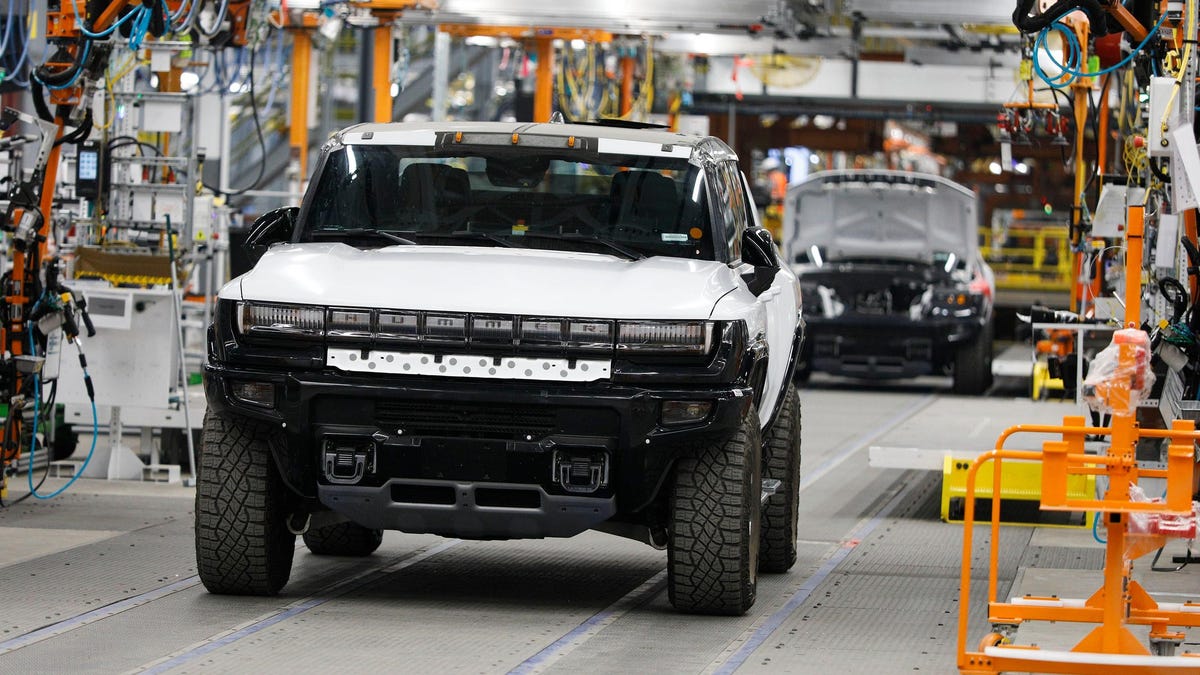Car Haulers Are Lobbying Congress to Raise Weight Limits in Order to Move More EVs

A GMC Hummer EV truck is shown at General Motors Factory Zero on August 5, 2021 in Detroit, Michigan. Photo: Photo by Bill Pugliano (Getty Images)
EVs are coming in mass quantities to roads near you, and car-haulers need to be able to haul more of them to help keep costs down and the market chugging along. But the weight increase haulers like the American Trucking Association are asking for — a full 8,000 pounds— could make our already deadly roads deadlier and already crumbling infrastructure more crumbly, all while worsening pollution.
Currently, federal limits stand at 80,000 pounds gross vehicle weight, 20,000 pounds on a single axle, and 34,000 pounds on a tandem axle group. The change would up limits to 88,000 pounds, allowing a car hauler to move the same number of EVs that it does traditional gas vehicles.
Car hauling companies have been busy pressing the flesh on Capitol Hill trying to get weight limits moved up. They say the increase is vital to the Biden Administrations plan for increasing EVs sales to half of all cars sold in the U.S. by 2030, as EVs which weigh significantly more than gas-powered vehicles, from Reuters:
Car haulers, the pipeline of the auto industry, move thousands of cars each day from factory parking lots, ports and rail yards to dealers, often using open double-decker trailers. If decades-old U.S. road weight limits are not increased, it could slow deliveries and increase costs, putting at risk this historic bet on zero-emission vehicles, they say.
“The truth is we will not be able move as many electric vehicles under the current weight limit. That could mean more trucks on the road, delays in orders and increased costs,” said Sarah Amico, executive chairman of Jack Cooper, among the largest car haulers in North America.
The only problem? American roads are already deadly enough. Nearly 43,000 Americans died on the roads in 2021—a 16-year-high. The presence of heavier, more cumbersome and more destructive trucks could exacerbate the problem. Trucks and SUVs in general are getting heavier, and there’s ample evidence that the heavier a vehicle is, the more destructive it performs in a crash. And heavier trucks will be harder to control, so they will crash. From North American Heavy Hauling:
A loaded tractor-trailer will require about 200 feet to come to a complete stop, compared to an ordinary passenger vehicle that needs about 135 feet. Stopping distance is a simple matter of physics and the laws of physics can’t be ignored. The more weight and mass a truck is hauling, the longer it will take to stop. For every 20,000 pounds added after the first 80,000 pounds, stopping distances will increase by a little over 25 percent.
G/O Media may get a commission
20% Off
JX Fitness Dumbbell Rack
Gains but tidy
Has a three-tier design to help store more weights more conveniently, can safely support up to 1000lbs of weight, which should be enough for most people, has a triangle base for stability, and also features anti-scratch feet which is great if you’ve built your own studio or workout in your garage.
It’s not just crashes with car haulers we have to worry about. Heavier loads wear down roads faster. A fully loaded, 80,000 pound truck does as much damage to a highway as 9,600 automobiles, according to the Government Office of Accountability. Seems silly to invest $1.2 trillion into fixing our garbage infrastructure just to run it into the ground again.
And then there’s the waste. For every 1,000 pound increase in vehicle weight, fuel economy drops by approximately 0.5 percent, according to truck manufacturer International. By increasing weight limits—which the government says are already ignored 22 percent of the time—we’d be increasing the worst kind of air pollution: particulate matter smaller than 2.5 micrometers in diameter, or PM 2.5. Particulate pollution is the deadliest form of background pollution, shaving 1.8 years off the average person’s lifespan, according to the World Economic Forum. It’s not even just emissions, the heavier a vehicle is the more micro plastics are generated from tire wear.



